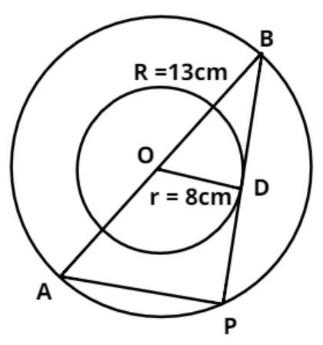
Answer
380.9k+ views
Hint – In this particular question use the concept that any tangent on the circle from any point makes an angle 90 degree with the radius of the circle and in any circle if the hypotenuse of the triangle is the diameter than the triangle inscribed in the circle always be a right angle triangle so use these concepts to reach the solution of the question.
Complete step-by-step answer:

The pictorial representation of the given problem is shown above in the figure.
Let O be the center of the two concentric circles as shown in the figure.
The radii of the bigger circle is 13cm and the lower circle is 8cm.
Therefore, OB = R = 13cm and OD = r = 8cm.
And AB is the diameter of the bigger circle so it is equal to the double the radius of the bigger circle so we have,
Therefore, AB = D = 2R = 2(13) = 26cm.
Now as we know that any tangent on the circle from any point makes an angle 90 degree with the radius of the circle.
Therefore, $\angle BDO = {90^o}$
Now we extend this tangent so that it intersects the bigger circle at point P, now join the point A and P.
If the hypotenuse of the triangle is the diameter then the triangle inscribed in the circle always be a right angle triangle.
So it also makes a 90 degree at point P.
Now consider the triangle OBD and ABP we have,
$\angle OBD = \angle ABP$ (Common)
$\angle ODB = \angle APB = {90^o}$
$\angle DOB = \angle PAB$ (Alternate angle)
So by AAA congruence, these two triangles are congruent.
So in congruent triangles the respective side ratio is always equal.
$ \Rightarrow \dfrac{{OB}}{{AB}} = \dfrac{{OD}}{{AP}} = \dfrac{{DB}}{{PB}}$
So we have,
$ \Rightarrow \dfrac{{OB}}{{AB}} = \dfrac{{OD}}{{AP}}$
Now substitute the values we have,
$ \Rightarrow \dfrac{{13}}{{26}} = \dfrac{8}{{AP}}$
Now simplify this we have,
$ \Rightarrow \dfrac{1}{2} = \dfrac{8}{{AP}}$
$ \Rightarrow AP = 2\left( 8 \right) = 16$cm.
So the length of the AP is 16cm.
So this is the required answer.
Note – We can also solve this type of question by using Pythagoras’ theorem in triangle OBD and ABP, i.e. ${\left( {{\text{hypotenuse}}} \right)^2} = {\left( {{\text{perpendicular}}} \right)^2} + {\left( {{\text{base}}} \right)^2}$,so by using this theorem in triangle OBD first find out the distance BD, then the distance BP is double the distance of BD, then again apply Pythagoras theorem in triangle ABP and find the distance AP, which is the required answer.
Complete step-by-step answer:

The pictorial representation of the given problem is shown above in the figure.
Let O be the center of the two concentric circles as shown in the figure.
The radii of the bigger circle is 13cm and the lower circle is 8cm.
Therefore, OB = R = 13cm and OD = r = 8cm.
And AB is the diameter of the bigger circle so it is equal to the double the radius of the bigger circle so we have,
Therefore, AB = D = 2R = 2(13) = 26cm.
Now as we know that any tangent on the circle from any point makes an angle 90 degree with the radius of the circle.
Therefore, $\angle BDO = {90^o}$
Now we extend this tangent so that it intersects the bigger circle at point P, now join the point A and P.
If the hypotenuse of the triangle is the diameter then the triangle inscribed in the circle always be a right angle triangle.
So it also makes a 90 degree at point P.
Now consider the triangle OBD and ABP we have,
$\angle OBD = \angle ABP$ (Common)
$\angle ODB = \angle APB = {90^o}$
$\angle DOB = \angle PAB$ (Alternate angle)
So by AAA congruence, these two triangles are congruent.
So in congruent triangles the respective side ratio is always equal.
$ \Rightarrow \dfrac{{OB}}{{AB}} = \dfrac{{OD}}{{AP}} = \dfrac{{DB}}{{PB}}$
So we have,
$ \Rightarrow \dfrac{{OB}}{{AB}} = \dfrac{{OD}}{{AP}}$
Now substitute the values we have,
$ \Rightarrow \dfrac{{13}}{{26}} = \dfrac{8}{{AP}}$
Now simplify this we have,
$ \Rightarrow \dfrac{1}{2} = \dfrac{8}{{AP}}$
$ \Rightarrow AP = 2\left( 8 \right) = 16$cm.
So the length of the AP is 16cm.
So this is the required answer.
Note – We can also solve this type of question by using Pythagoras’ theorem in triangle OBD and ABP, i.e. ${\left( {{\text{hypotenuse}}} \right)^2} = {\left( {{\text{perpendicular}}} \right)^2} + {\left( {{\text{base}}} \right)^2}$,so by using this theorem in triangle OBD first find out the distance BD, then the distance BP is double the distance of BD, then again apply Pythagoras theorem in triangle ABP and find the distance AP, which is the required answer.
Recently Updated Pages
How many sigma and pi bonds are present in HCequiv class 11 chemistry CBSE

Mark and label the given geoinformation on the outline class 11 social science CBSE

When people say No pun intended what does that mea class 8 english CBSE

Name the states which share their boundary with Indias class 9 social science CBSE

Give an account of the Northern Plains of India class 9 social science CBSE

Change the following sentences into negative and interrogative class 10 english CBSE

Trending doubts
Fill the blanks with the suitable prepositions 1 The class 9 english CBSE

Differentiate between homogeneous and heterogeneous class 12 chemistry CBSE

One Metric ton is equal to kg A 10000 B 1000 C 100 class 11 physics CBSE

Difference between Prokaryotic cell and Eukaryotic class 11 biology CBSE

Which are the Top 10 Largest Countries of the World?

Give 10 examples for herbs , shrubs , climbers , creepers

The Equation xxx + 2 is Satisfied when x is Equal to Class 10 Maths

Why is there a time difference of about 5 hours between class 10 social science CBSE

Difference Between Plant Cell and Animal Cell



